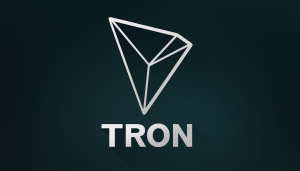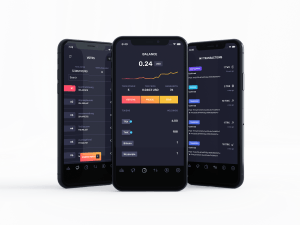TRX
TRON
TRON platform and its TRX coin want to bring the technology of distributed and decentralized data storage to the entertainment and content generation industry. It should make digital content distribution simpler and provide rewards for participation.
| Market Cap | Volume 24h | Circulating Supply | Maximum Supply |
|---|---|---|---|
| $7,220,107,641 | $5,514,890,752.00 | 92345222419.00000000 TRX | 92345222419.00000000 TRX |

What Is TRON?
Launched under the slogan of “Decentralize the Web” in September 2017, the TRON platform is promoted as the decentralized blockchain focused on smart contracts and high performance as the foundations of its content sharing system. While these features have been initially focused on the entertainment industry and content sharing, the TRON developers now promote their platform as a foundation of a “new” and decentralized World Wide Web. In addition to this, TRON wants to become a full-blown operating system developed with the goal of streamlining the deployment of custom decentralized applications (dApps).
What Is TRON Trying to Achieve?
TRON is big on becoming an ecosystem with a wide range of participants who should all be able to draw various benefits from it. Each participant who puts at least some effort in the development of this ecosystem should be rewarded for it, irrespective of their role in it.
With that in mind, TRON has been developed to give both Bitcoin and Ethereum run for their money with some of its key features:
- TRON wants to posit itself as the more flexible and lightweight option for the smart contract deployment. The TRON Virtual Machine (TVM) is compatible with Ethereum Virtual Machine (EVM), with planned support for several other VMs in the future. This should ensure that the deployment of applications and custom wallets on the TRON platform is done in a more flexible manner. TRON’s smart contract engine promotes effectiveness, is built around a lighter architecture and supports working with a larger number of users. Transfers of TRX and execution of smart contracts actually cost bandwidth points instead of tokens. Thus, deploying a DApp on the TRON network should allow the developers to benefit from lower development costs based on the bandwidth settings of the TRON TVM. At the same time, they should have direct access to various users who are in search of influencers, investment avenues and novel business ideas.
- TRON goes for three “highs” as its overall goals in the platform development: high throughput, high availability and high performance. The TRON team pairs its promise of resolving scalability issues with the prospects of having its users enjoy higher number of transactions per second (TPS) than its competitors in daily usage. At the moment, the TRON is billed as being capable of handling 2000 transactions per second at any time of day. Feeling that performance should come at no expense of the platform’s availability, the TRON team promises to offer network infrastructure capable of supporting a higher level of decentralization and a stimulating reward distribution mechanism.
- TRON aims to redefine the dominant practices in the content distribution and entertainment industries. Its stated goal is to remove the middlemen from the content creation process and reduce its dependence on the network resources controlled by the large corporations. With TRON, the content creators should be paid directly by the audience they serve, without resorting to the services of various intermediaries such as content distribution platforms. At the same time, the giants such as Facebook, Google and Amazon would have some of their monopolistic powers taken away, at least in the field of the monetization of traffic and user data.
- TRON wants to use the blockchain as the foundation of the future global content sharing system. With the promise of rewards for the content creators participating in its ecosystem, TRON hopes to expand its reach and employ its peer-to-peer (P2P) network technology for the purpose of becoming a global operating system for unrestricted storing and uploading of data of all types. This includes popular formats such as audio and video content as well as in-game currencies, all of which should be made available for distribution without restrictions.

What Is the Role of TRON Token in All of This?
The platform’s native asset, the TRON token (TRX) can be used to share content on the network or as a compensation for the content creators who contribute to the network. In addition, the token can be locked, allowing its users to acquire Tron Power (TP) which functions as the source of voting rights for its holder on the network.
In addition to this, TRON aims to offer infrastructure for the easier distribution of digital content such as games or videos, with the artists and designers retaining full ownership over their creations. This will be followed by the support for the organization of personal ICOs. CryptoPuppies was one of the first projects to be developed with the help of TRON platform as a collectible game involving the purchasing of virtual dogs with TRON coins.
In April 2019, the circulating supply of TRX coins amounted to 66 billion coins, out of the total supply of 99 billion TRX. At the same time, its market cap stood at USD 1.5 billion. TRX coins can be bought or traded on the major crypto exchanges it is listed on, such as Bitstamp or bitFlyer. TRON offers support for the dedicated wallets on its website which are available for iOS, Android, Windows and other platforms.
How Does TRON’s DPoS System Work?
TRX tokens cannot be acquired by mining. The platform uses TPOS mechanism which was built as a modified Delegated Proof-of-Stake (DPoS) consensus mechanism in which the transaction sizes, block intervals and fee schedules are handled by the elected delegates.
In this system, 27 so-called Super Representatives (SRs) are in charge of producing blocks. All changes that are planned for the introduction to the TRON network need to be voted on by the users who hold TRX tokens. The same goes for voting for the delegates tasked with taking care of the network, with 27 best ranking candidates being promoted to SRs. All of the processes are continuous and take place based on the performance of each delegate.
There are three types of nodes on the TRON platform:
- Witness nodes. These nodes are established by Super Representatives and are chiefly responsible for the creation of blocks, voting process and submission of proposals to be voted on.
- Full nodes. These nodes are in charge of APIs and broadcasting transactions and blocks.
- Solidity nodes. These nodes synchronize blocks coming from full nodes and also manage indexable APIs.

What Is the Three-Layer Architecture of TRON?
While the TRON platform is promoted as an inclusive ecosystem, its architecture is still designed so as to accommodate the participation of various stakeholders in it. Thus, it had to be built around a wide range of technologies, all performing different roles on the platform.
For starters, the architecture of TRON is organized into three basic layers:
- Storage Layer. This layer operates as a distributor protocol in charge of block storage and state storage. The concept of the underlying storage is developed around the model of graph database whose primary task is to meet the needs for diverse data storage in real-world applications. Graph storage does not include link list data structures or key and value storage such as those found in Bitcoin and Ethereum, going instead for the design which promotes speed for a broader range of applications. At the same time, TRON blockchain storage implements LevelDB technology which was developed by Google.
- Core Layer. This layer is the home to various modules on the TRON network (see below), account management and consensus mechanism features.
- Application Layer. This layer supports the operation of the TRON Virtual Machine and the accompanying programming languages while also interfacing with the software used in wallets.
What Are the Modules Found on the TRON?
While being tier-based, some parts of the TRON’s architecture are further segmented into several modules which perform various tasks. For starters, the Core Layer on the TRON hosts several modules:
- Consensus Module. This module performs all tasks related to the operation of the TRON’s DPOS consensus mechanism, including those which should allow it to reduce the electric power consumption at no cost in TPS performance.
- KhaosDB Module. This module is found in the full node memory and is capable of storing various newly forked chains for a set period of time. This is supposed to ease switching between active and new main chains for the witnesses. The module also plays a role in protecting the blockchain-based storage system from unplanned termination in an intermediate state and making it more stable in the process.
- Digital Token Module. This module is divided into two segments: the configuration module and the issuing and deployment module. The first one allows the users to customize their digital tokens via configuration settings. At the same time, the issue/deployment model allows the user to set appropriate parameters prior to issuing a token which can be defined as either default or custom settings.
- Smart Contract Module. Finally, this module makes it possible for users to create smart contracts which run on virtual machines.
The TRON Team
The TRON project came into existence in September 2017 as a brainchild of Chinese blockchain entrepreneur Justin Sun who serves as the project’s CEO. The initial coin offering (ICO) for TRX took place in August and September 2017 during which it raised USD 70 million. Sun is also the founder of the Singapore based non-profit organization called the Tron Foundation. Prior to this, Justin Sun worked as the chief representative and advisor to Ripple in the China region.
Current TRON team features more than 100 members coming from various places, ranging from Seoul to San Francisco. Key personnel involved in the project’s operation includes Lucien Chen, TRON’s Chief Technology Officer, Deuce Yu as the Product Manager and Charles Zhang as the Director of Operations.
